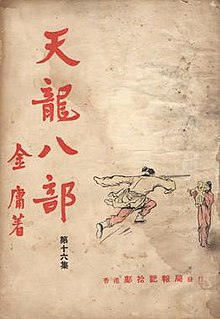Demi-Gods and Semi-Devils

Volume 16 of an early edition of Demi-Gods and Semi-Devils
|
|
| Author | Jin Yong |
|---|---|
| Original title | 天龍八部 |
| Country | Hong Kong |
| Language | Chinese |
| Genre | Wuxia |
| Publisher | Ming Pao, Nanyang Siang Pau |
|
Publication date
|
3 September 1963 |
| Media type | |
| Demi-Gods and Semi-Devils | |||||||||||
| Traditional Chinese | 天龍八部 | ||||||||||
|---|---|---|---|---|---|---|---|---|---|---|---|
| Simplified Chinese | 天龙八部 | ||||||||||
| Literal meaning | The Deva, the Nāga, the Eight Sections | ||||||||||
|
|||||||||||
| Transcriptions | |
|---|---|
| Standard Mandarin | |
| Hanyu Pinyin | Tiān Lóng Bā Bù |
| Yue: Cantonese | |
| Jyutping | Tin1 Lung4 Baat3 Bou6 |
Demi-Gods and Semi-Devils is a wuxia novel by Jin Yong (Louis Cha). It was first serialised concurrently from 3 September 1963 to 27 May 1966 in the newspapers Ming Pao in Hong Kong and Nanyang Siang Pau in Singapore. The novel has since spawned several adaptations in film and television in mainland China and Hong Kong.
The novel's title has been a challenge for translators for years. The major characters in the novel are based on the eight races of non-human demi-gods and semi-devils described in Buddhist cosmology. In Buddhism, these demi-gods and semi-devils are ranked higher than mortals but are still bound to Saṃsāra by their own desires. It is said that Jin Yong originally modelled each major character after one of the races, but, as he continued writing, the complexity of the story made it impossible for such a simplistic mapping. An alternative English title of the novel is Eight Books of the Heavenly Dragon.
The main thematic element of the novel concerns the complex, troubled relationships between the great multitude of characters from various empires and martial arts sects, and the inherent bond that underlies the struggles of each. The novel examines the cause and effect that forms and breaks these bonds on five uniquely corresponding levels: self, family, society, ethnic group, and country (dominion). The novel is primarily set in the Northern Song dynasty (960–1127) of China, but its setting also covers the non-Han Chinese empires of Liao, Dali, Western Xia and Tibet.
The plot is made up of separate yet intertwining story lines revolving around three protagonists – Qiao Feng, Duan Yu and Xuzhu – who become sworn brothers in chapter 41. The complex narrative switches from the initial perspective of Duan Yu to those of the other main characters and back.
Duan Yu is a young and naïve prince of the Dali Kingdom. His reverence for Buddhist teachings and disdain for bloodshed prompt him to defy his family's tradition of practising martial arts. He runs away from home when his father, Duan Zhengchun, tries to force him to learn martial arts. Ironically, for the sake of survival, he ends up mastering three powerful skills and becomes a formidable martial artist. In addition, he acquires immunity to poison after accidentally consuming the Zhuha, a venomous toad.
...
Wikipedia
